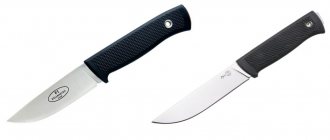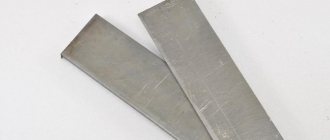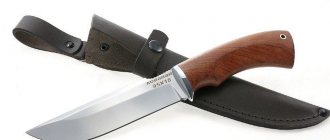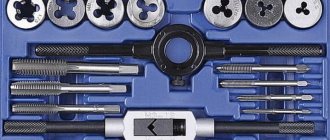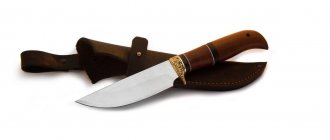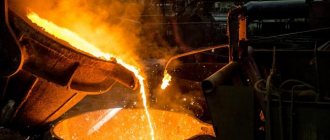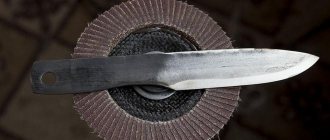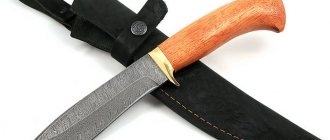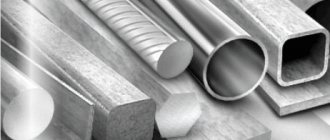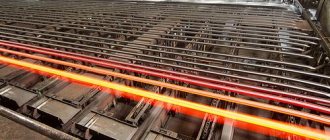What were you interested in when you typed “D2 steel” in the search? The characteristics of this steel, its pros and cons, whether it is suitable for making knives or were you simply interested in its chemical composition. Perhaps you wanted to buy strips or forgings of D2 steel and make a knife yourself? Today we will tell you everything we know about this steel, and also tell you where to buy D2 steel most profitably.
Steel D2 - Analogs
Let's start with analogues. Perhaps now you will say: “Oh, yes, this is our steel X...” and you will not read further. Take your time, the list of analogues is below, and then we’ll sort everything out.
Steel D2 - original. Developed in the USA, developed a long time ago, back in the 60s and for the needs of American industry. Currently they are produced in other countries, including Russia. Steel has the following generally accepted designations:
- X155CrMo12 - D2 steel is produced under this brand in Germany
- 1.2379 - this is how D2 steel is marked according to the European steel designation system
- SLD - that's what they mean in Japan
- SKD-11 - D2 steel marking in Sweden
- And of course, X12MF - an analogue of D2 steel is produced under this brand in Russia.
The Russian analogue of D2 steel is Kh12MF
We have sorted out the analogues and designation of D2 steel. The chemical composition is also not complicated.
Chemical composition of D2 steel
| Carbon (C), % | 1,55 |
| Manganese (Mn), % | 0,35 |
| Chromium (Cr), % | 11-13 |
| Silicon (Si), % | 0,45 |
| Molybdenum (Mo), % | 0,90 |
| Vanadium (V), % | 0,90 |
| Steel hardness D2, HRC | 57-61 |
As you can see, the chemical composition of D2 steel is “not rich,” but, as they say, “less is better,” namely, a well-chosen composition of chemical elements in D2 steel gives it all those positive characteristics, which we will discuss below.
History of the appearance of the alloy
Steel grade D2 plate 250x80x4 mm. The alloy was developed in America in the 60s. for industrial purposes (production of knives and cutting tools). Nowadays such steel is produced not only in the USA. Alloys similar in composition to D2 have been developed in Japan, Germany and Sweden. The only difference is the amount of carbon.
The alloy has the following designations:
- X155CrMo12 – produced in Germany;
- 1.2379 – this is how D2 is marked according to the European steel designation system;
- SLD – alloy in Japan;
- SKD-11 – D2 marking in Sweden.
In Russia there is also an analogue - X12MF.
The alloy is actively used in the metalworking industry, automotive industry, and in the production of razor blades. In addition, it is used to create edged weapon blades.
Advantages and disadvantages
Like any alloy, D2 steel has its pros and cons. Its advantages are manifested:
- in the high hardness of the cutter, the ability to hold an edge for a long time;
- resistance to deformation;
- resistance to corrosion, although steel is not stainless;
- resistance to high temperatures;
- homogeneity of the internal structure after hardening;
- significant wear resistance;
- ability to withstand dynamic loads;
- quite affordable price.
The obvious advantages of knives made of D2 steel have made them popular among hunters and tourists. Household knives for use in the kitchen are also very popular.
The disadvantages of the alloy are mainly associated with its advantages, in particular:
- due to their high hardness, sharpening knives requires special tools, which is difficult to accomplish in field conditions;
- Despite their high resistance to corrosion, knives require careful care and avoidance of contact with aggressive environments.
Knives made from D2 steel are considered the best option for use in any conditions. With proper storage and proper care, they will last a long time, effectively performing their functions.
D2 steel pros and cons
The steel has a very high Rockwell strength; in our production it is 63-64 units. Technologically, this characteristic can vary from 55 to 69! units, but we settled on exactly 63-64, as on the golden mean, with low strength, the knives quickly become dull, and with too high strength, it is difficult to straighten.
Steel was originally conceived as a knife steel. Accordingly, there will be quite a lot of advantages, but there will also be a fly in the ointment.
Pros:
- high mechanical strength,
- sharp cutting edge, due to the carbon content it produces a very aggressive cut,
- high degree of corrosion protection,
- The cutting edge can be sharpened to razor sharpness. It will hold an edge for an extremely long time.
There are also small disadvantages.
Minuses:
- Although the steel is semi-stainless, it requires minimal maintenance.
- does not tolerate lateral loads well, it is better not to pull out nails with it, for example,
- high strength makes sharpening in “field” conditions problematic.
Results:
- good value for money,
- holds an edge for a long time, but takes time to edit,
- requires minimal care, is not intended for chopping and throwing, does not like lateral loads.
Advantages
Many experts classify d2 as a premium material. Due to the high content of chromium and carbon, steel is highly resistant to corrosion and does not deform under heavy loads. The hardness of the finished steel is HRC 55-69 units. Knives made from D2 have excellent cutting properties. They retain their original sharpness for a long time. Experts believe that d2, although it has good anti-corrosion properties, cannot be 100% considered real stainless steel.
Numerous tests helped scientists determine several important properties of the metal that are indispensable in the production of knives:
- high mechanical strength;
- sharp cutting edge;
- 100% corrosion protection;
- increased wear resistance;
- can be polished - the knife blade always has a mirror surface;
- simple sharpening.
The high quality of the alloy allows it to be used in the production of important parts in the food industry.
Chemical composition
Alloy D2 is based on high carbon steel. The carbon content in its composition is 1.4-1.6%. Its high concentration promotes the formation of large amounts of iron carbide. It is given special strength and wear resistance by refractory metals, the concentration of which is:
- molybdenum – 0.8-1.2%;
- tungsten – 0.9-1.1%.
They are introduced into the molten metal in powder form and replace iron in compounds with carbon. Strong tungsten and molybdenum carbides are formed, giving the metal the following properties:
- high strength when heated;
- hardening ability;
- uniform distribution of internal stresses arising during the hardening process;
- prevent fragility.
The anti-corrosion characteristics of D2 steel are increased by the addition of chromium in an amount of more than 11%. Additional strength is given to the alloy by chromium carbides formed during the interaction of elements.
Silicon and manganese are added in equal proportions, 0.6% each, and provide a stabilizing and strengthening effect on the internal structure of the alloy.
It is known that sulfur and phosphorus contribute to the deterioration of mechanical properties, reduce wear resistance, while simultaneously increasing the fragility of the metal. The content of these elements is reduced to the extent that their harmful effects do not affect the quality of steel:
- sulfur – 0.03%;
- phosphorus – 0.04%.
Rating - top 10 steels
The most popular and durable brands of steel for knives.
Steel M390
Austrian-made steel has confidently maintained a high level of popularity for several years. Well-known knife manufacturing companies actively use it in their production. According to its characteristics, M390 steel belongs to the premium segment, but it is not easy to harden, and it is its quality that has a decisive influence on the final result.
M390 is martensitic chromium powder steel. It is widely used in the machine tool industry, where it is necessary to process hard materials, in the manufacture of surgical and medical instruments, and in the production of medium and high-class knives.
Compound:
- chromium – 20.0%;
- vanadium – 4.0%;
- carbon – 1.9%;
- molybdenum – 1.0%;
- silicon – 0.7%;
- tungsten – 0.6%;
- manganese – 0.3%.
The advantages of M390 are high anti-corrosion performance, excellent wear resistance and cutting ability.
The only disadvantages include the need to properly harden and sharpen professionally.
Analogues of M390 steel: CTS-XHP, CTS 204P, Duratech 20CV (CPM 20CV).
Steel D2
D2 steel is time-tested, showing good and stable performance, combined with an adequate cost. This is a tool alloy. Country of origin: USA.
The scope of application is quite wide, even despite the possibility of corrosion. In industry, it is widely used for the manufacture of high-speed cutters.
Compound:
- chromium – 12.0%;
- vanadium – 1.1%;
- carbon – 1.5%;
- molybdenum – 1.0%;
- silicon – 0.6%;
- nickel – 0.3%;
- manganese – 0.6%.
Their D2 steel knives retain their sharpness for a long time due to the high strength of the material. But there is no 100% rust protection.
Analogs of D2 steel: X12MF, X155CrVMo12-1.
Steel X12MF
Steel grade X12MF, Russian production, alloyed tool stamped. It is quite easy to process, has high anti-corrosion properties and is inexpensive.
Widely used in the production of complex-shaped products for heavy engineering. Demanded for the manufacture of hunting knife blades. On the Rockwell scale, hardening is 59-61 units.
Compound:
- chromium – 11.75%;
- vanadium – 0.07%;
- carbon – 1.55%;
- molybdenum – 0.5%;
- silicon – 0.3%;
- nickel – 0.35%;
- manganese – 0.3%.
Advantages: hardness, high cutting properties, wear resistance.
Analogs of steel Kh12MF: D2, Kh6VF, Kh12F1, Kh12VM, 2310, 1.2379.
Steel ELMAX
Austrian Elmax steel is a powdered tool metal characterized by very high anti-corrosion properties. It is strong, easy to sharpen, and durable. In combination with this, Elmax has a low cost, providing an ideal balance of price and quality.
It has found wide application in the manufacture of knife blades, as well as cutting elements of machines for processing plastic products.
Compound:
- chromium – 18%;
- vanadium – 3%;
- carbon – 1.7%;
- molybdenum – 0.1%;
- silicon – 0.8%;
- manganese – 0.3%.
Advantages: a blade made of Elmax steel has high cutting properties, is easy to sharpen, and will not rust.
Among the negative characteristics, low fracture strength should be noted.
Analogues of ELMAX steel: S30V, RWL34.
Steel 95Х18
Alloyed martensitic stainless steel from a Russian manufacturer. Difficult to process, very demanding on hardening, but inexpensive in comparison with analogues. Hardening range: 58 - 60 HRC.
It is used in the manufacture of machine parts subject to high wear: bushings, bearings, axles, etc.
Compound:
- chromium - 18%;
- nickel - 0.6%;
- carbon - 1.95%;
- silicon - 0.8%;
- manganese - 0.8%.
Pros: stainless material, strength, wear resistance (subject to the hardening process).
Disadvantages: steel is difficult to process and does not withstand heavy fracture loads.
Analogues of steel 95Х18: 440B, 440C, 1.4125
Steel VG-10
High carbon, corrosion resistant Japanese steel. The cobalt used in the composition gives special hardness and viscosity. Hardening range: 60 - 63 HRC. Many global brands choose VG-10 for making blades for their knives.
Compound:
- chromium - 14.5-15.5%;
- cobalt - 1.3-1.5%
- carbon - 0.95-1.05%;
- molybdenum - 0.9-1.2%;
- vanadium - 0.10-0.30%.
Pros: high corrosion resistance, easy to sharpen, retain factory sharpness for a long time.
Cons: high cost due to the use of cobalt.
Analogs of VG-10 steel: ATS-34, ATS-55.
Steel CPM S30V
High carbon stainless steel made in the USA. Knives made from it have high cutting properties and are particularly durable. The most balanced of its kind in composition. Hardening range: 58 - 60 HRC. Used to produce knife blades from many well-known companies.
Compound:
- chromium - 14%;
- carbon - 1.45%;
- molybdenum - 2.0%;
- vanadium - 4.0%.
Pros: knives of this steel cut well, are break-resistant and wear-resistant. Ideally suited for serial and piece production of knives of the middle and high segment.
Analogues: D2, 440C and 154CM.
Steel 440C
Another American-made steel grade. Chrome, hard stainless steel. For its properties (it keeps the cutting edge sharp for a long time and is easy to sharpen) it is widely used in the manufacture of blades. 440C steel is considered the standard among knife steels.
Compound:
- chromium - 17%;
- phosphorus - 0.04%;
- carbon - 1.1%;
- silicon - 1.0%;
- molybdenum - 0.75%;
- sulfur - 0.03%.
Advantages: the cutting edge retains its sharpness for a long time, stainless material, easy to sharpen with high hardness.
The disadvantage is the rather high price in a similar segment.
Analogues: 95Х18, X102CrMo17, Z100CD17, AUS-10.
Steel AUS-8
Stainless steel made in Japan. Combined with a relatively low price, they give the products sufficient mechanical endurance, flexibility and hardness. Hardening range: 56-59 HRC. The application area is mainly focused on knife making.
Compound:
- chromium - 14.5%;
- manganese – 0.4%;
- carbon - 0.8%;
- silicon - 0.6%;
- molybdenum - 1.1%;
- vanadium – 0.3%.
Pros: blades made of AUS-8 steel have excellent cutting properties, withstand mechanical stress well, and will not rust.
Analogues of AUS-8 steel: 440С, AEB-L, 8Cr13MoV, 75Х16МФ, 95Х18.
Technical features of D2 steel
There are five characteristics to evaluate an alloy:
- Hardness. It has a high rate of up to 64 HRC according to Rockwell.
- Rigidity. It is durable, but is not rigid enough, which leads to inconvenience when sharpening products.
- Wear resistance to abrasive effects. Due to its hardness, this alloy has a high indicator.
- Corrosion resistance. This type of steel is not stainless because it does not contain enough chromium, but it resists rust. Corrosion resistance is rated as average.
- Protection of edges from rubble. During operation, the blade of a D2 product can maintain its sharpness for a long time.
Characteristics of steel
The properties of steel depend on the addition of alloying substances to the alloy. But in general, the material for making knives is valued for the following characteristics:
- strength, elasticity, which gives the product resistance to longitudinal bending;
- withstands a wide range of temperatures (from - 30 to + 100 degrees Celsius);
- hardness, which is assessed on the Rockwell scale (the optimal indicator for knives is 55 units or higher);
- resistance to external influences, anti-corrosion properties;
- duration of sharpening retention (the blade will dull less often on a product made of hard steel, but it is more difficult to sharpen it and it is better to have it done by professionals).
The best kitchen knives in the world - top 10
Alloy properties
Although D2 steel has high anti-corrosion properties, it is not considered completely stainless. Corrosion resistance largely depends on operating and storage conditions. If products are left in a humid environment for a long time, rust stains may appear on them.
The physical and technical characteristics of D2 steel allow it to be used after appropriate heat treatment for the production of tools with high wear resistance and shock resistance:
- density – 7700 kg/m3; thermal conductivity indicator – 20 W/m2*deg;
- elasticity coefficient – 21*104 MPa;
- compressive strength increases from 1750 to 2200 MPa with increasing hardness in the range from 52 to 62 HRC.
Heat treatment
D2 steel is produced by the electroslag remelting (ESR) method, in which the molten metal is passed through a special flux. During the process, harmful impurities of sulfur and phosphorus are removed from the melt as much as possible, thereby improving the quality of the metal.
To obtain the required strength characteristics for knives, D2 steel is subjected to further heat treatment. During hardening, it is important to ensure uniform heating of the entire mass of metal, for which a short delay is sufficient. Heating is carried out in an oxidizing environment, which causes partial decarburization of the surface layer. It is removed during final processing.
The primary hardness of the metal is achieved by hardening at 1000-1010 degrees with exposure for 5-7 minutes. The tempering temperature range is 175-200 degrees. This mode ensures maximum cutting edge hardness – 61-62 HRC.
To make knives intended for certain dynamic loads, the steel hardening mode changes slightly:
- hardening - at a temperature of 1020-1040 degrees;
- vacation - 310-340 degrees for two hours.
The final mechanical processing of products consists of grinding and sharpening the cutter.
Thermo-mechanical treatment conditions
This type of steel requires hardening, which gives it greater strength. To harden an alloy not intended for making blades, an oxidizing atmosphere is used. Creating blades from D2 steel requires a different technology.
Heat treatment of D2 steel
For the production of cutting blades and parts designed for dynamic loads, different exposure times and temperatures are required. The most common treatment of steel for primary hardness, including low tempering and quenching in oil, under a stream of air or in hot environments.
To achieve uniformity in the structure of the blade, ensure uniform heating during hardening. The absence of oxidation during such processing prevents decarburization, which helps maintain strength and make the product more sharp.
Heating occurs at a temperature of +690…+850°C. After a few minutes or seconds, the alloy is cooled and alloyed with vanadium and molybdenum, which promotes hardening.
The production uses the electroslag remelting method. The molten metal is passed through a layer of slag, in the process being cleansed of harmful impurities, including sulfur and phosphorus.
After processing followed by heating, the steel is cooled and subjected to final mechanical processing in the form of grinding and sharpening the blade.
Flaws
For all its advantages, steel has several negative characteristics. They affect the effectiveness of the future product. The following factors are considered the main disadvantages:
- The ESR melting method is used to produce steel. The molten metal is passed through a small layer of slag. There remains “steel debris” in it, which is removed. Thus, sulfur and phosphorus are eliminated from the steel. In Russia, this technology is called electroslag remelting.
- Prolonged contact with aggressive environments causes rust to appear on the knife blade.
- “Semi-stainless steel” requires constant maintenance. Products must be dried thoroughly. Their prolonged presence in a humid environment is unacceptable.
- The blade is afraid of lateral loads. It cannot be used as a chisel or nail puller.
- It is very difficult to sharpen a knife at home. Special industrial equipment is required.
- Finish polishing cannot be performed.
- The strength of other types of steel of a similar class is much higher.
Analogues of the alloy and its application
The D2 steel grade was developed in the 60s of the last century in the United States and was originally used for industrial needs. The alloy was used to make high-speed metal cutters that could operate at high temperatures. Today this brand is popular all over the world and has many analogues:
- Х155CrMo12 – in Germany;
- SLD - Japan;
- 1.2379 – in the European Union;
- SKD-11 - Sweden.
In Russia, a substitute for D2 steel is the X12MF grade, the composition of which is regulated by GOST 5950. Its range is represented by:
- various types of rental;
- calibrated rod and silver;
- strip and forged blanks.
Tool steel D2, like its analogues, has found wide application:
- in the engineering industry;
- production of metalworking tools;
- razor blades.
It is especially in demand as a material for the manufacture of elite knives, which is due to its ability to maintain a good sharpening for a long time. Normally it should be enough to cut up a large carcass. A wide range of knives are made from the alloy:
- universal folding ones, including gift options;
- neck hunting knives designed for skinning prey;
- tourist, having a wide range of applications;
- cutting, for cutting large carcasses.
Comparative characteristics of steel D2 and Kh12MF
The analogue in the Russian Federation is steel X12MF.
D2 steel contains carbon. Vanadium is used as alloying elements, which reduces the fragility of the blade, molybdenum improves the hardenability of the material to the full depth. Chromium protects steel from corrosion, but its level is not sufficient to classify the steel as stainless. Also, having melted, it is alloyed with silicon and manganese, the first element strengthens the steel grains, the second increases its hardness.
- Carbon – 1.4-1.6%.
- M-0.9-11%
- Mo- 0.8-1.2%
- Cr-11%.
The steel has a very aggressive and long lasting cut. Easy to sharpen and straighten. It is advisable to use ceramic abrasives for sharpening; diamonds form a too rough cutting edge. Or use diamond abrasives for initial roughening, and then move on to ceramics.
The steel resists corrosion quite well, but it cannot be classified as stainless steel because it lacks chromium. The knives will require simple care; wash and wipe after use. Pitting corrosion can be easily removed with a regular eraser.
The optimal heat treatment mode is 58-60 units. According to Rockwell, with such hardness the blade has balanced characteristics. The sharpness of the cutting edge is well maintained and at the same time the edge is not prone to chipping under strong lateral or impact loads. In the case of heat treatment at a hardness of 60-62 units. according to Rockwell, wear resistance increases noticeably, but at the same time the knife becomes brittle. For example, if you hit a bone with a knife while cutting up a carcass, you can get chips.
The advantages of knives from D2 include:
- Long time of maintaining the sharpness of the cutting edge;
- Good corrosion resistance;
- It has sufficient mechanical strength to withstand chopping blows without damage;
- As a rule, knives made of this steel have an acceptable cost.
The disadvantages include;
- In conditions of prolonged exposure to a humid environment, it is prone to the formation of corrosion spots;
Knives made of D2 steel. Minuses
This steel, of course, has its disadvantages. Any steel has its downsides. D2 has almost one - the steel is not completely stainless. Given the high percentage of carbon in the steel, knives made of D2 can be coated with “pitting”, i.e. slight pitting corrosion, and when in contact with acidic environments, the blade may darken slightly, here is an example:
Pitting corrosion on a knife blade made of D2 steel, as well as a mark from contact with a lemon.
How to get rid of this? Just! Don’t forget about the banal knife care: “I used the knife, washed it, wiped it!” That's all. Pitting corrosion on a knife made of D2 steel will not be a problem. And in case of darkening upon contact with lemon, you can lightly polish it.
Many manufacturers apply an anti-corrosion coating to D2 steel blades, but in my opinion this is unnecessary - the coating will quickly wear off, and additional treatment costs extra money.
One piece of advice: “When buying a knife from D2, X12MF, etc. pay attention to the polishing of the knife. The better the knife is polished, the less susceptible it is to corrosion. This also applies to knives made of other steel grades.
Variety of products from D2
A wide range of different knives are produced from D2 tool steel. Among them:
- folding - for universal purposes, including in gift wrapping;
- neck ones, with the help of which you can skin an animal killed during a hunt and carefully remove its skin;
- tourist, with a fixed blade and a wide range of applications;
- cutting machines, which will help cut the animal carcass into pieces and chop the bones.
High-quality knives made of D2 steel can be purchased in the online store KavkazSuveninr Ali Askerov, among them: hunting, tourist, folding. Our website also presents tactical survival knives made by the best Kizlyar craftsmen, including products made from D2 steel.
Also in our online store there are many handmade knives for various purposes. All of them are characterized by high accuracy and compliance with the required product parameters, aesthetics, and the use of natural materials for decoration.
Domestic knife manufacturers are increasingly using modern and high-quality alloys in the production of knives, and among them, D2 steel (D2), which has gained wide popularity.
For many years, knives made from D2 steel have remained popular and in demand in many countries around the world. The high qualities of d2 steel, with its pros and cons, made it possible to use this metal to create various cutting tools in industries such as:
- metalworking;
- automotive industry;
- production of razor blades.
The blade never crumbles or jams. The knife cuts nails freely, while the cutting edge remains intact and maintains operating parameters.
Prolonged contact with water causes corrosion. This knife cannot be used at home. The blade begins to become rusty.
Hunting
For a real hunter, it is very important to have a good knife. It must easily withstand enormous loads and help in carrying out complex long-term work: cutting up a carcass, sanding it. The metal of a hunting knife must be hard and highly durable. Alloy and carbon steel are suitable for the blade.
Several important qualities of a hunter’s weapon depend on the chemical composition of the metal:
- the blade must remain sharp for a long time;
- do not be afraid of mechanical loads;
- have high cutting characteristics;
- tolerate temperature changes freely, maintaining its original properties.
Blades made of alloy or carbon steel are subject to corrosion. To increase their service life, the blade undergoes special treatment. After washing, it is thoroughly wiped, the dry surface is lubricated with a thin layer of industrial oil. Knives made from tool alloy steel are much less likely to develop corrosion stains. They can be used for work in high humidity.
Tourist
Knives for tourists are made from tool steel with a high content of carbon and chromium. Factories in Japan and the USA use D2 steel for the production of tourist knives. It is considered the best in the world for the production of blades. This material is characterized by increased corrosion resistance and the ability to maintain a sharp cutting edge for a long time. The hardness of the metal after heat treatment reaches HRC 60-62 units.
Since the chromium content in D2 is slightly lower than in real stainless steel, professionals advise thoroughly wiping the blades after work and trying not to leave the knife in places with high moisture content.
Household
Knives for household purposes are rarely made from d2, because during the production process the design of the tool has to be changed. A striking example of such a product is a blade made on the basis of the Uzbek sharp knife pchak. He is engaged in the creation of such devices. To obtain high-quality products, specially developed technology is used.
The knife is made in such a way that it does not need to be sharpened, but only slightly adjusted. As a result, the thickness of the cutting edge is maintained. It usually does not exceed 0.1 mm. In eastern countries, such a blade is considered a universal device. It cuts the ram freely and can be used as a military weapon.
In recent years, the domestic industry has mastered the production of special kitchen knives made of D2 steel. The “Vegetable” and “Universal” blades are especially popular. High-carbon, semi-stainless steel d2, with a hardness of 61-62 units, allows you to perform any operations in the kitchen. Unfortunately, the cost of such products is very high (6000 -7000 rubles).
Knife Long Jack (steel D2, handle - Karelian birch)
Zorg folding knife (D2 GT steel, G10 handle)
Where can I buy?
There are many manufacturers of knives made of steel D2, X12MF... in Russia and abroad. Internet to help). But you can buy strips made from the German analogue of D2 steel, but they are less common..
Do you make your own knives? We brought this steel from Germany for you. The certificate, as they say, is attached:
Certificate for steel D2 (Germany)
Brought in sheets measuring 700x2000 mm, cut into strips on site. What do we cut with? Many people do not like laser, plasma or guillotine cutting. Therefore, we cut with a regular grinder. What sizes? We will cut off the ones that are needed. They brought a lot, so the prices are reasonable. For example:
- retail price of D2 strip size 250x40x4 (raw) ... 640 rubles
- retail price of D2 strip size 250x40x4 (hardened) ... 790 rubles
- small wholesale price (5 stripes) ... 5% discount
- small wholesale price (10 strips) ... 10% discount
- wholesale prices from 30 strips...on request.
For comparison, here are prices for a similar size in “other places”:
Prices for D2 steel at Artwood
Prices for D2 steel on Guns.ru
D2 steel prices at Foreshome
Let's summarize. Excellent steel, which has all the necessary characteristics for the manufacture of knife products. Now available in a variety of strip sizes for those making their own knives. If necessary, we will carry out heat treatment and surface grinding.
Plates, forgings of D2 steel for those who make their own knives. Buy D2 steel for knives in strip plates in our online store. Are you used to buying on AliExpress? You can now buy D2 steel from Germany on this site with free delivery. Here is the link.
Price
Knives made of D2 steel are produced by both domestic and foreign manufacturers. The products are low in cost. This is due to the fact that all the components that are used to produce this grade of steel are available and cheap. The average price for a knife is 2,500 rubles. Due to their low price and excellent characteristics, knives made from D2 steel are popular among buyers, especially among hunters and tourists.
Sources
- https://VashNozh.ru/stal/d2
- https://svarkaipayka.ru/material/stal/tehnicheskie-harakteristiki-legirovannoy-stali-d2.html
- https://damask-steel.ru/page/d2-plyusy-i-minusy-harakteristiki-otzyvy/
- https://www.nozhikov.ru/blogs/stati/stal-d2-kak-material-dlya-izgotovleniya-klinkovogo-oruzhiya
- https://kavkazsuvenir.ru/blog/stal-d2-dlya-nozhey
- https://posuda-gid.ru/nozhi/stal/35-d2-plyusy-i-minusy
- https://knifehacker.ru/stal-d2/
- https://top-nozhej.ru/bez-rubriki/stal-d2-dlja-nozhej-harakteristiki-pljusy-i-minusy/
